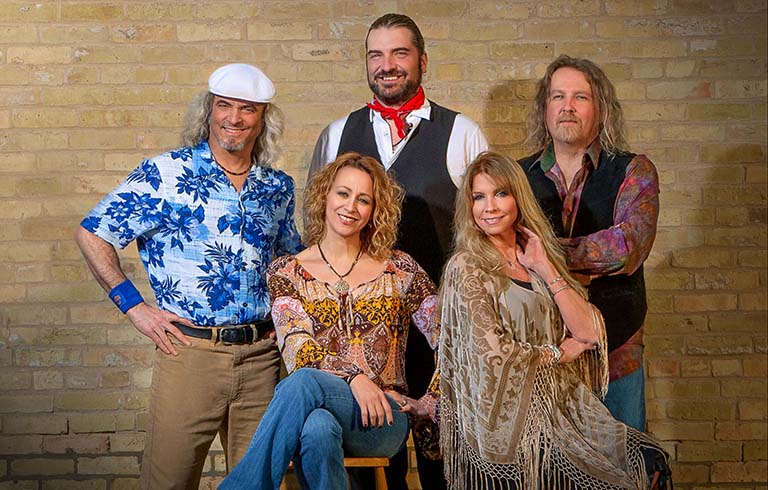
Tusk: Fleetwood Mac tribute coming to Trine Nov. 17
Tusk, the Ultimate Fleetwood Mac Tribute, will bring the band’s greatest hits to the stage of Trine University’s T. Furth Center for Performing Arts on Friday, Nov. 17.
April 19, 2021

HUNTSVILLE, Ala. — For the second year in a row, a team of Trine University design engineering majors has won a major award at the NASA Human Exploration Rover Challenge (HERC).
Winners for the 2021 competition were announced during a virtual awards competition on Friday, April 16. Trine University’s team was made up of juniors Hailey Dunham and Emily Rumph, and seniors Graham Hemingway, Nicolas Kane, Alec Pruett and Jacob Stout.
Trine won the Task Challenge Award, presented to the team producing the best 3D printed tool design that could be used by lunar and Martian rovers to retrieve samples while on those respective surfaces. NASA said the goal of the task challenge is to help improve 3D manufacturing technology for future space missions.
For the task challenge, this year’s teams had to design and 3D print a tool to retrieve three different liquid samples. The team also created a one-minute video that showcased the use of the tool for the NASA judges.
The only guidance given was that tools had to be completely 3D printed, except for the stage container/storage area and connecting appendages, and that the tool had to prevent cross-contamination of samples.
“Our rover design team performed exceptionally well during the pandemic and came together to create a functional (and winning) tool design that was 3D printed in our own labs,” said Tim Jenkins, Ph.D., associate professor of design engineering technology and faculty advisor for the project. “Hailey, Emily and the rest of the team demonstrated the skills necessary to succeed. I am elated for them and how well they represented themselves, our Design Engineering Technology department and Trine University.”
Dunham, who spearheaded the tool design for the Trine team, said that after brainstorming, the team opted for a longer tool to make it easier to collect samples. Dunham said that to make best use of Trine’s 3D printing equipment, she decided to print multiple components that fit together.
“The main idea I had was to make male and female ends that would slide together to create a nearly seamless transition between components,” she said. “I also decided to make small holes for a pin to slide through the interlocking ends and ensure that the components would not fall apart during use on the rover. The handle used a simple triangular shape that was comfortable to sit in the rider's hand and make maneuvering the tool easy.”
The jar holder was the tool’s most complicated component, Dunham said.
“This component needed to hold the sample collection container while in use and be removed for the excursion,” she explained. “The final design included using the jar's threads. The idea was to screw the jar into the tool, collect the sample and unscrew. This motion would be easy for a rider and astronaut to handle.”
The design forced team members to reverse engineer from the thread size used on nontraditional plastic jars. Dunham said she reached out to Trine faculty for help in determining the thread size. Design Engineering Technology department staff assisted her as she printed the final prototypes.
“I am very happy with the overall design of the jar,” she said. “I am amazed and excited that the team won this award.”
Video of Dunham demonstrating the tool, with Stout driving the rover, is available at youtube.com/watch?v=nPpaRHnoThE
Trine’s 2020 team won the AIAA Best Report Award in the College and University Division. That award recognizes the high school and college reports that best describe their technical design process for the Rover Challenge.
The Rover Challenge tasks U.S. and international student teams to design, engineer and test a human-powered rover on a course that simulates the terrain found on rocky bodies in the solar system. Teams also must perform mission tasks while negotiating the course, including sample retrievals and spectrographic analysis.
High school and college teams competed in multiple design, documentation and presentation categories, and were recognized for their successful efforts in nine categories.
“The challenges you faced with this competition go beyond anything we’ve seen before, from designing the wheels and mission tools to executing mission requirements like sample retrievals and deploying instruments,” said Marshall Center Director Jody Singer. “To all of the students who took on these tasks and participated in Rover Challenge, we salute you and congratulate you on your accomplishments.”
“The students really had to think outside the box to figure out how to develop these robust vehicles during a global pandemic,” said Miranda Fike, activity lead for the challenge at Marshall. “These members of the Artemis Generation rose to the occasion and delivered their reviews, presentations, designs and videos without fail.”
The competition is one of seven NASA Artemis Student Challenges, named for the next effort to send humans to the moon and Mars. It is sponsored by NASA's Human Exploration and Operations Mission Directorate and Office of STEM Engagement Next Gen STEM in Washington; and managed by Marshall's Office of STEM Engagement.
The challenge was launched in 1994 as the NASA Great Moonbuggy Race to commemorate the 25th anniversary of the Apollo 11 lunar landing. Expanded in 1996 to include high school teams, the race evolved again in 2014 into the Human Exploration Rover Challenge.
Photo: Trine University’s 2021 NASA Rover team, from left, Graham Hemingway, Nick Kane, Hailey Dunham, Tim Jenkins, Ph.D., Emily Rumph, Alec Pruett and Jacob Stout. The team only removed masks momentarily for the purposes of the photo. (Photo by Dean Orewiler)
Last Updated: 04/19/2021